|
|
 |
Fiche d'espèce de Copépode |
|
|
Calanoida ( Ordre ) |
|
|
|
Clausocalanoidea ( Superfamille ) |
|
|
|
Scolecitrichidae ( Famille ) |
|
|
|
Lophothrix ( Genre ) |
|
|
| |
Lophothrix latipes (T. Scott, 1894) (F,M) | |
| | | | | | | Syn.: | Scolecithrix latipes T. Scott, 1894 b (p.52, Descr.F, figs.F); Giesbrecht & Schmeil, 1898 (p.48, Rem.F);
Scolecithrix angusta Esterly, 1911 (p.328, figs.F); in CalCOFI regional list (MDO, Nov. 2013; M. Ohman, comm. pers.).
Scolecithrix acutus Wolfenden, 1911 (p.253, figs.F);
Scolecithrix acuta : Farran, 1926 (p.266);
? Scaphocalanus pacificus Mori, 1932 a (p.169, figs.F); Mori, 1937 (1964) (p.49, figs.F); Chiba & al., 1955 (p.192); Sewell, 1948 (p.561); Kos, 1972 (Vol.I, figs.F, Rem.);8Bradford, 1973 (p.144, Rem.); Park, 1982 (p.77); Ohtsuka & al., 2015 (p.123, Rem.: p.125).
Scolecithricella angusta : Sewell, 1948 (p.557, 563);
no Lophothrix latipes (M): C.B. Wilson, 1950 (p.252, figs.M)
Lophothrix angusta : Gopalakrishnan & Balachandran, 1992 (p.167, figs.1, 5, Table 1, 2); | | | | Ref.: | | | Sars, 1925 (p.165, figs.F); Farran, 1929 (p.209, 254); Rose, 1933 a (p.146, figs.F); Farran, 1936 a (p.98); Lysholm & al., 1945 (p.27); C.B. Wilson, 1950 (part., p.251, fig.F, no M); Brodsky, 1950 (1967) (p.246, figs.F); Vervoort, 1965 (p.61, Rem.); Owre & Foyo, 1967 (p.68, figs.430-431 as laticeps); Vilela, 1968 (p.18, figs.juv.F); Park, 1968 (p.554, figs.F); Bradford, 1973 (p.144); Roe, 1975 (p.313, Descr.M, figs.M); Björnberg & al., 1981 (p.637, figs.F); Bradford & al., 1983 (p.88, 90, Rem.F,M, figs.F); Park, 1983 (p.177, 188, Redescr.F, figs.F); Bradford-Grieve, 1999 (p.881, 932, figs.F,M); Conway & al., 2003 (p.203, figs.F,M, Rem.); Boxshall & Halsey, 2004 (p.187, fig.F); Vives & Shmeleva, 2007 (p.746, figs.F,M, Rem.) | 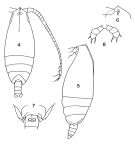 Issued from : T.S. Park in Fishery Bull. Fish Wild. Serv. U.S., 1968, 66 (3). [p.553, Pl.8, Figs.4-8]. Female: 4, habitus (dorsal); 5, idem (left lateral side); 6, forehead (ventral view); 7, last thoracic segment and genital somite (ventral); 8, P5. Nota: The posterolateral corner of the metasome (Fig.7) is produced into a point, the tip of which in dorsal or ventral view curves inward and reaches to about the middle of the genital somite. The genital somite has a ventral projection in the form of a shovel.
|
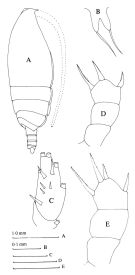 Issued from : J.M. Bradford, L. Haakonssen & J.B. Jillett in Mem. N.Z. oceanogr. Inst., 1983, 90. [p.90, Fig.52]. Female: A, habitus (lateral right side); B, rostrum; C, endopod of P2; D, P5; E, P5 ( specimen from another station)
|
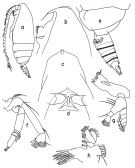 issued from : T. Park in Antarct. Res. Ser. Washington, 1983, 38 (3). [p.189, Fig.13]. Female (from SW Atlantic: 34°45'S, 49°38'W): a, habitus (lateral left side); b, forehead (lateral); c, idem (dorsal); d, idem (ventral); e, last thoracic segments and urosome (lateral left side); f, A2; g, Md; h, Mx1. Nota: Urosome about 22/100 length of prosome. Spermatheca of an elongate vesicle.
|
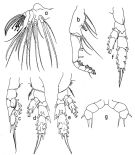 issued from : T. Park in Antarct. Res. Ser. Washington, 1983, 38 (3). [p.190, Fig.14]. Female: a, Mx2; b, Mxp; c, P1 (anterior); d, P2 (posterior); e, P3 (posterior); f, P4 (posterior); g, P5 (posterior).
|
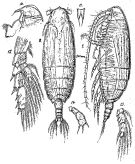 Issued from : G.O. Sars in Résult. Camp. Scient. Prince Albert I, 69, pls.1-127 (1924). [Pl.XLVI, figs.8-14]. Female: 8, habitus (dorsal); 9, idem (lateral left side); 10, forehead (lateral); 11, rostrum; 12, P2; 13, endopodal segments of P3; 14, P5.
|
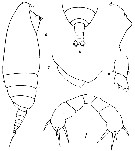 issued from : R.N. Wolfenden in Die Marinen Copepoden der Deutschen Südpolar-Expedition 1901-1903, 1911. [p.254, Fig.32]. As Scolecithrix acutus. Female: a, habitus (lateral); b, posterior part cephalothorax and urosome (dorsal); c, last thoracic segment (lateral, right side); d, outer margin of Mxp; e, basipod segments of P3; f, P5.
|
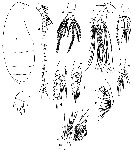 issued from : T. Mori in The pelagic Copepoda from the neighbouring waters of Japan, 1937 (2nd edit., 1964). [Pl.24, Figs.1-11]. As Scaphocalanus pacificus. With doubt. Female (23°8'42''N, 122°13'5''E): 1, orosome (lateral); 2, A1; 3, urosome (dorsal); 4, A2; 5, P4; 6, P3; 7, P2; 8, P5; 9, P1; 10, Mx1; 11, Mxp. Nota: - Head without a median crest. - Cephalosome and 1st thoracic segment fused , 4th and 5th segments separated. - Lateral angles of the last thoracic segment pointed but not produced into spines. - Rostrum bifurcate, each ramus has an articulated slender apical spine. - Genital segment 2 times as long as the next 2 segments together. - A1 shorter than the body. - P5 resembles Scaphocalanus acutus Wolfenden but the distal 2 segments of endopodite of P4 has no spines on the posterior side; 2nd segments shorter than the 1st.
|
 issue from : C.O. Esterly in Univ. Calif. Publs Zool., 1911, 6 (14). [Pl.28, Fig.42]. As Scolecithrix angusta. Female (from San Diego Region): 42, habitus (lateral). Nota: Cephalothorax 5-segmented, 4th and 5th separated, the last segment ends in a point and below this is a deep notch. Abdomen 4-segmented and with the caudal rami is about one-fifth the length of the cephalothorax. Genital segment as long as the 2nd and 3rd segments together (these are of equal lengths) and about 4 times as long as the anal segment. A1 reach back to the posterior border of the genital segment. Mx2 with 8 vermiform sensory appendages
|
 issue from : C.O. Esterly in Univ. Calif. Publs Zool., 1911, 6 (14). [Pl.29, Figs.46, 51]. As Scolecithrix angusta. Female: 46, parts of last two thoracic segments and urosome (lateral); 51, forehead (lateral). Nota: head with a long, low, and the rostrum is heavy and stiff crest
|
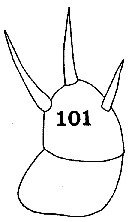 issue from : C.O. Esterly in Univ. Calif. Publs Zool., 1911, 6 (14). [Pl.31, Fig.101]. As Scolecithrix angusta. Female: 101, P5. Nota: P5 are phyllous, 2-segmented, and the distal segment has 3 spines.
|
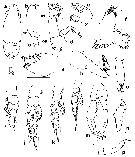 issued from : H.S.J. Roe in Bull. British Mus. (Natural History) Zool., London, 1975, 28 (7). [p.314, Fig.10]. Male (NE Atlantic): a, habitus (dorsal); b, forehead and rostrum (right lateral side); c, thoracic segments 4 and 5 (right lateral side); d, A2; e, mandibular palp; f, Mx1; g, Mx2; h, Mxp; i, P1; j, P2; k, P3; l, P4; m, P5; n, P5 (last exopodite segment right leg); o, P5 (terminal exopodite segments left leg); p, P5 (last endopodite segment left leg). Bar scale 0.1 mm unless indicated. Nota: Cephalothoras 3.4 times as long as the 5-segmented abdomen. Head and 1st thoracic segment fused, 4th and 5th separate. Head with a low crest and forehead angular in lateral view. Rostrum with 2 thick filaments. The hind margin of the 1st thoracic segment is undulating and the ventro-lateral margin of the 5th thoracic segment is abruptly cut off. A1 20-segmented, reaches to the end of the cephalothorax.. Mandible blade, Mx1, Mx2 and mxp reduced. Endopod of Mx2 with 6 sensory setae, none of which are brush-like. P5 asymmetric, reach back to the hind edge of the 3rd abdominal segment; in the right leg , the exopodite has 4 segments, the last of which is flattened and roughly triangular in shape; the endopodite is short and has 2 segments; the left leg has longer basipodite segments , exopodite with 3 segments, endopodite with 2 segments; the last exopodite segment has 2 wide setae and numerous spines; the endopodite terminates in a ribbon-like seta.
|
 issued from : H.B. Owre & M. Foyo in Fauna Caribaea, 1, Crustacea, 1: Copepoda. Copepods of the Florida Current. [p.67, Figs.430, 431, 435]. Female: 430, habitus (lateral); 431, rostrum; 435, P5. Nota: P5 symmetrical, with all the spines short and about equal in length.
|
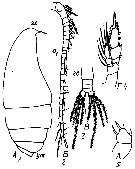 Issued from : M.C. Kos in Field guide for plankton. Zool Institute USSR Acad., Vol. I, 1972. After Mori, 1932. As Scaphocalanus pacificus with douubt. Female: 1, celalothorax (lateral); 2, A1; 3, abdomen (dorsal); 4, P4; 5, P5.
| | | | | Ref. compl.: | | | Sewell, 1948 (p.348, 516, 546, 557, 562); Chiba & al., 1957 a (p.11); Grice & Hart, 1962 (p.287, 293: Rem.); Björnberg, 1963 (p.41, Rem.); Unterüberbacher, 1964 (p.24); De Decker & Mombeck, 1964 (p.13); Mullin, 1966 (p.546, Table I, III, diet); Fleminger, 1967 a (tabl.1); Morris, 1970 (p.2301); Deevey, 1971 (p.224); Roe, 1972 (p.277, tabl.1, tabl.2); Deevey & Brooks, 1977 (p.256, tab.2, Station "S"); Carter, 1977 (1978) (p.35); Dessier, 1979 (p.205); Kovalev & Shmeleva, 1982 (p.83); Vives, 1982 (p.292); Dessier, 1983 (p.89, Tableau 1, Rem., %); Brenning, 1984 (p.4, Rem.); Guangshan & Honglin, 1984 (p.118, tab.); Brenning, 1985 a (p.28, Table 2); Rudyakov, 1986 (tab.2); Suarez & al., 1990 (tab.2); Suarez & Gasca, 1991 (tab.2); Hattori, 1991 (tab.1, Appendix); Suarez, 1992 (App.1); Suarez-Morales & Gasca, 1998 a (p.111); Lopez-Salgado & al., 2000 (tab.1); Lapernat, 2000 (tabl.3, 4); Kuriyama & Nishida, 2006 (p.299: Tab.II, fig. 10: vertical distribution ); Williamson & McGowan, 2010 (p.273, Table 3, Pacific central gyres: N and S); Schnack-Schiel & al., 2010 (p.2064, Table 2: E Atlantic subtropical/tropical); Dias & al., 2010 (p.230, Table 1); Andersen N.G. & al., 2011 (p.71, Fig.3: abundance); in CalCOFI regional list (MDO, Nov. 2013; M. Ohman, comm. pers.); Lidvanov & al., 2013 (p.290, Table 2, % composition); Bonecker & a., 2014 (p.445, Table II: frequency, horizontal & vertical distributions); Belmonte, 2018 (p.273, Table I: Italian zones); Dias & al., 2019 (p.1, Table II, IV, occurrrence, vertical distribution) | | | | NZ: | 15 | | |
|
Carte de distribution de Lophothrix latipes par zones géographiques
|
| | | | | | | | | | | | 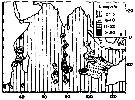 issued from : T.C. Gopalakrishnan & T. Balachandran in Oceanogr. Indian Ocean, 1992. [p.171, fig.5, B]. As Lophothrix angusta. issued from : T.C. Gopalakrishnan & T. Balachandran in Oceanogr. Indian Ocean, 1992. [p.171, fig.5, B]. As Lophothrix angusta.
Distribution of Lophothrix latipes in the Indian Ocean.
Nota: Main occurnces between 10° N - 40° S. |
| | | | Loc: | | | South Africa (E), Namibia, G. of Guinea, Brazil, off Rio de Janeiro, The Campos Basin, off Macaé, off Amazon, Dakar, Cape Verde Is., off NW Cape Verde Is., off Morocco-Mauritania, Canary Is., off Madeira, Portugal, Bay of Bicay, Venezuela, G. of Mexico, Florida, Sargasso Sea, off Bermuda: Station ‘’ S’’ (32°10’N, 64°30’W), SW Ireland, Medit. (off Monaco, Ionian Sea, Cyprus), Natal, Madagascar (Nosy Bé), S Indian Ocean, Philippines, China Seas (East China Sea, South China Sea), Taiwan, Japan, Sagami Bay, off Sanriku, ? Bikini Is., Pacif. (N central subtropical), Pacif. (W equatorial), Pacific (central gyres: N and S), Australia (Great Barrier), Tasman Sea, New Zealand, off N Hawaii, California | | | | N: | 70 | | | | Lg.: | | | (1) F: 3; (6) F: 2,96; (8) M: 3,19-2,96; (9) F: 3,05; 2,9; (10) F: 2,65; (16) F: 3,2-3; (34) F: 2,88; (35) F: 3-2,8; (38) F: 3,1; (47) F: 3,2; (72) F: 3,23-3,03; (91) F: about 2,6; (143) F: 3,14; (199) F: 3,12-2,81; 3,12-2,96; (237) F: 3,0; (432) F: 3,25-2,86; (991) F: 2,65-3,2; M: 2,96-3,19; (1000) F: 2,0 ± 0,1; (1111) F: 2,98-3,3; (1230) F: 2,6; {F: 2,60-3,30; M: 2,96-3,19} | | | | Rem.: | épi-bathypélagique.
Une contradiction apparaît dans les données de Sars (1925) concernant la station 769 (Monaco): Lophothrix latipes est noté à cette station mais non considéré comme présente en Méditerranée (p.165, 166). Sa présence en Méditerranée orientale confirmerait sa présence dans le bassin occidental. Rose (1933 a) ne la considère pas comme présente en Méditerranée.
Voir aussi les remarques en anglais | | | Dernière mise à jour : 19/01/2021 | |
|
|
 Toute utilisation de ce site pour une publication sera mentionnée avec la référence suivante : Toute utilisation de ce site pour une publication sera mentionnée avec la référence suivante :
Razouls C., Desreumaux N., Kouwenberg J. et de Bovée F., 2005-2026. - Biodiversité des Copépodes planctoniques marins (morphologie, répartition géographique et données biologiques). Sorbonne Université, CNRS. Disponible sur http://copepodes.obs-banyuls.fr [Accédé le 07 janvier 2026] © copyright 2005-2026 Sorbonne Université, CNRS
|
|
 |
 |















